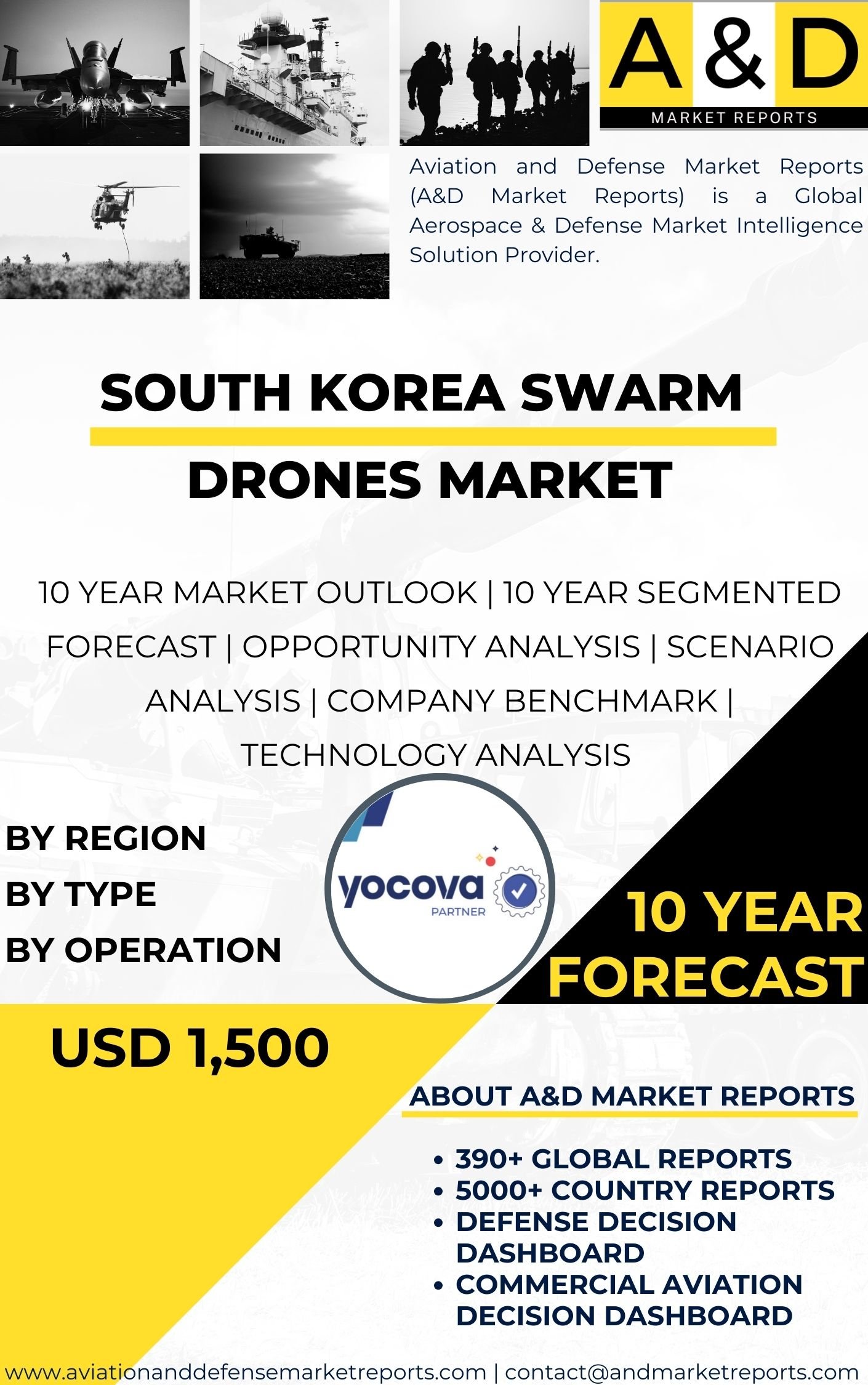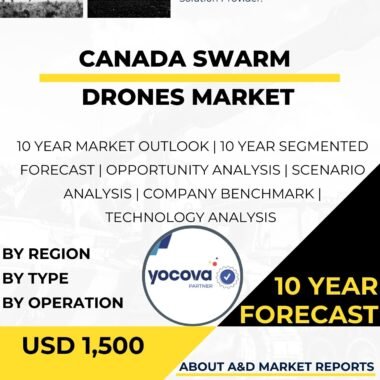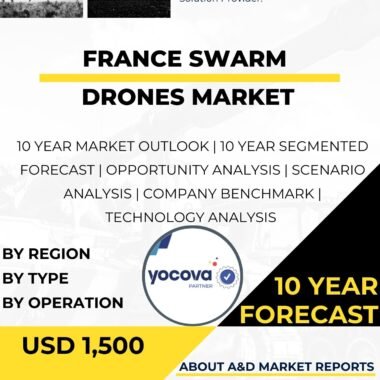Description
South Korea has emerged as a significant player in the global swarm drones market, harnessing the power of innovative technologies to bolster its military capabilities and strategic position in an evolving security landscape. Swarm drones, also known as drone swarms, involve the coordinated deployment of multiple unmanned aerial vehicles (UAVs) that work together to perform a wide range of missions, including reconnaissance, surveillance, target identification, and electronic warfare.
One of the driving forces behind South Korea’s interest in swarm drones is the need to enhance its defense capabilities, particularly in the face of regional security challenges. By adopting swarm tactics, South Korea aims to improve its situational awareness, detect and respond to threats more effectively, and strengthen its deterrence capabilities. This approach is especially relevant in the Asia-Pacific region, where the strategic use of swarm drones can be a game-changer in modern warfare scenarios.
South Korea’s commitment to technology innovation and research and development has positioned it as a leader in the swarm drones market. The nation has invested significantly in the creation of advanced UAVs with swarm capabilities, including autonomous decision-making, communication, and coordination. These drones are designed to operate in complex and contested environments, providing valuable assets for military operations and intelligence gathering.
Furthermore, South Korea actively engages in international defense collaborations and partnerships, which have contributed to its swarm drones capabilities. Joint ventures with global defense companies have facilitated technology transfer and knowledge sharing, allowing South Korea to leverage the expertise of its international partners and integrate cutting-edge swarm technology into its military strategies.
Additionally, South Korea’s development of swarm drones extends beyond military applications. The nation recognizes the potential for drone swarms in civilian sectors, such as disaster response, agriculture, and environmental monitoring. This dual-use approach not only enhances South Korea’s technological proficiency but also fosters innovation and economic growth.
In conclusion, South Korea’s investment in swarm drones reflects its commitment to defense modernization and the advancement of its military capabilities. By embracing innovative technologies and fostering international collaborations, South Korea positions itself as a formidable player in the global swarm drones market. As the security landscape continues to evolve, South Korea’s expertise in swarm tactics and autonomous UAV systems will play a pivotal role in enhancing regional stability and security.
Table of content
Table Of Contents
1 Market Introduction
1.1 Market Introduction
1.2 Market Definition
1.3 Market Segmentation
1.4 10 Year Market Outlook
2 Market Technologies
3 Global Market Forecast
3.1 Global Market Forecast
3.2 By Type
3.3 By Operation
4 APAC Market Trends & Forecast
4.1 Drivers, Restraints And Challenges
4.2 PEST
4.3 Market Forecast
4.3.1 Market Forecast By Type
4.3.2 Market Forecast By Operation
4.4 Scenario Analysis
4.5 Key Companies& Profiling
5 South Korea Analysis
5.1 Current Levels Of Technology Maturation In This Market
5.2 Market Forecast
5.2.1 Market Forecast By Type
5.2.2 Market Forecast By Operation
5.3 Scenario Analysis
5.4 Country Defense Budget (Historical and 10- year forecast)
5.5 Defense Budget Category Spending- 10- year forecast
5.6 Procurement Analysis
5.7 EXIM Data
5.8 Patents
6 Opportunity Matrix
6.1 By Type
6.2 By Operation
7 Scenario Analysis
7.1 Scenario 1
7.1.1 By Type (Scenario-1)
7.1.2 By Operation(Scenario-1)
7.2 Scenario 2
7.2.1 By Type (Scenario-2)
7.2.2 By Operation(Scenario-2)
8 Company Benchmark
9 Strategic Conclusions
10 About Aviation And Defense Market Reports
Segments
By Type
By Operation
List of Tables
Table1: Global Market Forecast, Swarm Drones Market
Table2: APAC Market Forecast, Swarm Drones Market
Table3: APAC Market Forecast, By Type
Table4: APAC Market Forecast, By Operation
Table5: APAC, Scenario Analysis
Table6: South Korea Market Forecast, Swarm Drones Market
Table7: South Korea Market Forecast, By Type
Table8: South Korea Market Forecast, By Operation
Table9: South Korea, Scenario Analysis
Table 10: South Korea Defense Budget 10 Year Forecast
Table 11: South Korea, Defense Budget Category Spending- 10- year forecast
Table 12: South Korea, Procurement Analysis
Table 13: South Korea, EXIM Data Analysis
Table 14: South Korea, Opportunity Analysis, By Type
Table 15: South Korea, Opportunity Analysis, By Operation
Table 16: South Korea, Scenario Analysis, By Type
Table 17: South Korea, Scenario Analysis, By Operation
Figure 1: Market Segmentation, South Korea Swarm Drones Market
Figure 2: Key Technology Analysis, Swarm Drones Market
Figure 3: Global Market Forecast, Swarm Drones Market
Figure 4: APAC, Market Forecast, Swarm Drones Market
Figure 5: APAC, Market Forecast, By Type
Figure 6: APAC, Market Forecast, By Operation
Figure 7: APAC, Scenario Analysis
Figure 8: South Korea, Market Forecast, Swarm Drones Market
Figure 9: South Korea, Market Forecast, By Type
Figure 10: South Korea, Market Forecast, By Operation
Figure 11: South Korea, Scenario Analysis
Figure 12: South Korea, Defense Budget 10 Year Forecast
Figure 13: South Korea, Defense Budget Category Spending- 10- year forecast
Figure 14: South Korea, Procurement Analysis
Figure 15: South Korea, EXIM Data Analysis
Figure 16: South Korea, Opportunity Analysis, By Type
Figure 17: South Korea, Opportunity Analysis, By Operation
Figure 18: South Korea, Scenario Analysis, By Type
Figure 19: South Korea, Scenario Analysis, By Operation
Figure 20: Company Benchmark




